
What’s Up Doug? Rolling Element Bearings and Fluid Power
August 5, 2016 | By Douglas Martin
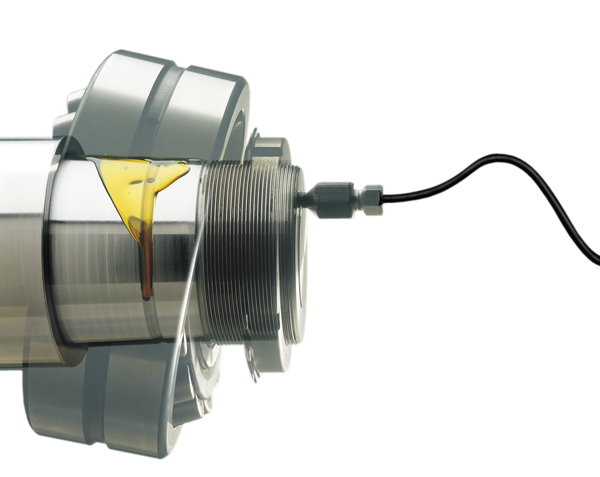
There are a number of ways that rolling element bearings and fluid power are related. Fluid power is used for installation of rolling bearings, removal of rolling bearings and lubrication of rolling bearings.
In many cases, the oil used in a hydraulic system is also used as a bearing lubricant. As a general rule, the needs of the hydraulic system are more stringent than the needs of the bearing. One case of interest is when the (lack of) health of the hydraulic system’s oil causes bearing failure, not from a bearing lubrication issue, but rather that the preload that was supposed to be applied to the bearing by the hydraulic system was not applied due to failure of hydraulic valves from dirt in the hydraulic oil.
Bearing removal
The removal of bearings from their seating is a timesaver for maintenance departments. There are two classes of bearing seats – tapered and straight. For straight bearing seats (shaft and housing), pre-drilled channels and passages allow one to apply a film of oil under high pressure, between the bearing surface and its seat. This high-pressure film, expands or compresses the bearing ring and eliminates the interference between the two surfaces, allowing a lower force to be used to axially pull or push the surfaces apart.

But what is required for this? The shaft and housing have to have these hydraulic passages designed into the equipment when it is originally designed and manufactured. This can be a problem as it means a greater expense to the original equipment when it is made. While the cost of the piece of equipment, when new, generally comes from the capital budget of the project, the cost savings made from the quick bearing removal of the bearing comes from the maintenance or operating budget. So as a general rule, the features required for quick hydraulic removal on a straight fit are not found in most machines as the extra cost is often vetoed at the time of the project build.
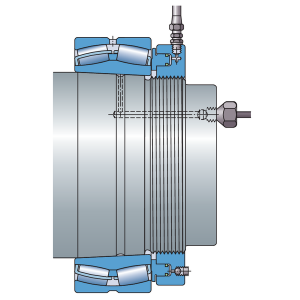
Standard features
However, some traditional industries have established that these features provide enough benefit that they are “standard” features. As an example, the rolls and housings of many paper machines have hydraulic removal features on their rolls, shells and journals. Since these rolls are designed to be re-covered on a regular basis, these features have become a “standard” feature in a roll or shell design to allow the bearings to be easily removed and reused.
For bearings with tapered bearing bores, the tapered journal or tapered sleeve can have the hydraulic channels included. By applying hydraulic pressure, the bearings will essentially “pop” off the shaft. As noted for straight shafts, tapered journal shafts are most often associated with paper making and are expected in their designs.
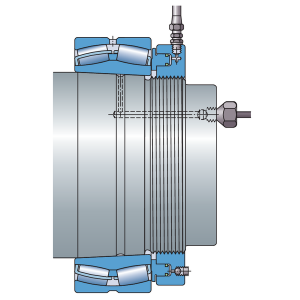
Adapter sleeves
In terms of hydraulic features on adapter sleeves, the additional cost of the hydraulic sleeves are about four times the cost and, as noted above, this cost does not represent a return on investment in the capital budget and therefore they are not selected on the original design.
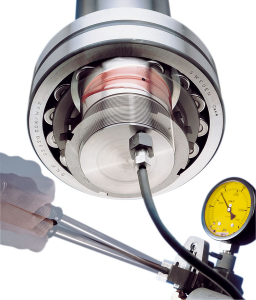
Withdrawal sleeves
Withdrawal sleeves, in which the sleeve is pulled from underneath the bearing for removal, a hydraulic nut can be used. A hydraulic nut is essentially an annular hydraulic piston that pulls the sleeve from under the bearing. The downside to withdrawal sleeve is that it generally requires a more complex shaft design than with an adapter sleeve (extra capital cost). The tools used to install the bearing are also different than the tools used to install the bearings, which is an additional cost.
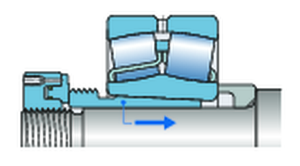
Hydraulic nuts
For installation, hydraulics are most often used with hydraulic nuts. A hydraulic nut is essentially an annular piston. The hydraulic pressure is used to push the bearing up a set distance to achieve an interference fit. That distance is measured either by the measurement of the change of clearance (how much you have stretched the inner ring) or how much you have pushed it up a set taper angle.
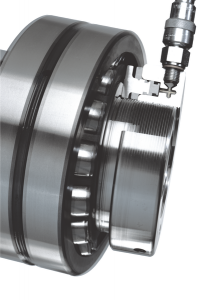
For tapered bore bearings over about 100mm (4”), the only effective manner to install a bearing is with a hydraulic nut.
Within the past few years, hydraulics have also been used to more accurately install bearings. A low hydraulic pressure is applied to the bearing with a tapered bore to establish a starting point for drive up. Once this “known” starting point is established, hydraulic pressure is used to drive the bearing up a specific distance, applying a more accurate interference than the traditional drive up or clearance reduction method.
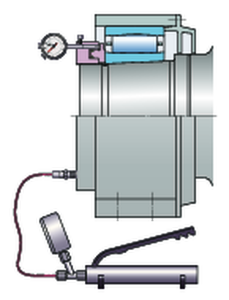
Fluid power can play an important role in the installation and removal of bearings. The use of fluid power can save significant time in the installation and removal of bearings. In addition, it can avoid the dangers of open flame and sparks that often require additional work permits to a job. With the use of the correct fluid power equipment, time and money can be saved.
Douglas Martin is a heavy-duty machinery engineer based in Vancouver. He specializes in the design of rotating equipment, failure analysis and lubrication. Reach him by email at mro.whats.up.doug@gmail.com.
